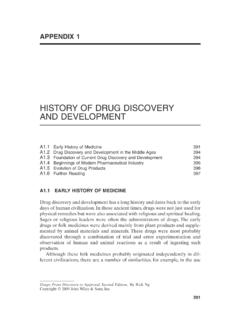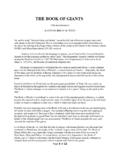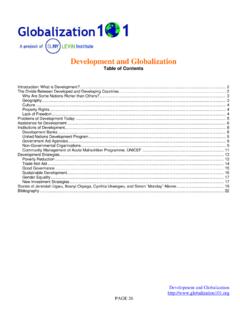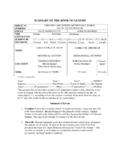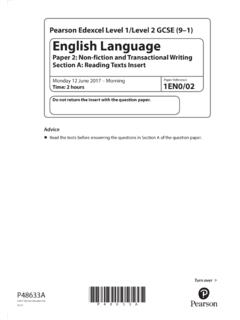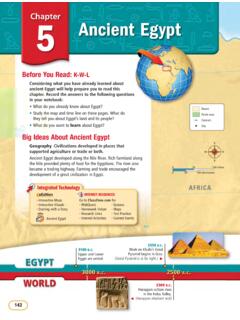Transcription of HISTORY OF DRUG DISCOVERY AND DEVELOPMENT
1 APPENDIX 1. HISTORY OF drug DISCOVERY . AND DEVELOPMENT . Early HISTORY of Medicine 391. drug DISCOVERY and DEVELOPMENT in the Middle Ages 394. Foundation of Current drug DISCOVERY and DEVELOPMENT 394. Beginnings of Modern Pharmaceutical Industry 395. Evolution of drug Products 396. Further Reading 397. EARLY HISTORY OF MEDICINE. drug DISCOVERY and DEVELOPMENT has a long HISTORY and dates back to the early days of human civilization. In those ancient times, drugs were not just used for physical remedies but were also associated with religious and spiritual healing.
2 Sages or religious leaders were often the administrators of drugs. The early drugs or folk medicines were derived mainly from plant products and supple- mented by animal materials and minerals. These drugs were most probably discovered through a combination of trial and error experimentation and observation of human and animal reactions as a result of ingesting such products. Although these folk medicines probably originated independently in dif- ferent civilizations, there are a number of similarities, for example, in the use Drugs: From DISCOVERY to Approval, Second Edition, By Rick Ng Copyright 2009 John Wiley & Sons, Inc.
3 391. 392 HISTORY OF drug DISCOVERY AND DEVELOPMENT . of the same herbs for treating similar diseases. This is likely to be a contribu- tion by ancient traders, who in their travels might have assisted the spread of medical knowledge. Folk medicines were the only available treatments until recent times. drug DISCOVERY and DEVELOPMENT started to follow scientific techniques in the late 1800s. From then on, more and more drugs were discovered, tested, and synthesized in large-scale manufacturing plants, as opposed to the extraction of drug products from natural sources in relatively small batch quantities.
4 After World War I, the modern pharmaceutical industry came into being, and drug DISCOVERY and DEVELOPMENT following scientific principles was firmly established. Although pharmaceutical drugs are now widely used worldwide, many ethnic cultures have retained their own folk medicines. In certain instances, these folk medicines exist side by side and are complemented by pharmaceuti- cal drugs. The following are some snapshot examples of how drugs were discovered from the early human civilizations. Chinese Medicine Traditional Chinese medicine (TCM) is believed to have originated in the times of the legendary emperor Sheng Nong in 3500 bc.
5 The dynasty system and meticulous recording have helped to preserve the TCM scripts of old China. Some important medical writings are Shang Han Lun (Discussion of Fevers), Huang Di Nei Jing (The Internal Book of Emperor Huang), and Sheng Nong Ben Cao Jing (The Pharmacopoeia of Sheng Nong a legendary emperor). Exhibit relates a legend about the DISCOVERY of a herb for treating injuries. The Chinese pharmacopoeia is extensive. Some of the active ingredients from Chinese herbs have been used in Western drugs; for example, reserpine Exhibit A Legend about San Qi Chinese legend describes the story of the emperor Sheng Nong, who one day tried to kill a snake by beating it.
6 The snake returned a few days later, apparently none the worse after the beating. He beat it again and left it mortally injured. Again, the snake returned several days later. This time, after the beating, he observed that the snake crawled back into the bush and ate a plant material. This plant is now called San Qi (Panax notogin- seng) and is used for treating external injuries. It is an ingredient for the well-known TCM herbal formula known as Yunnan Bai Yao. Source: Reid D. Chinese Herbal Medicine, Shambhala Publications, Boston, 1996. EARLY HISTORY OF MEDICINE 393.
7 From Rauwouofia for antihypertensive and emotional and mental control, and the alkaloid ephedrine from Mahuang for the treatment of asthma. egyptian Medicine Ancient papyrus provided written records of early egyptian medical knowl- edge. The Ebers papyrus (from around 3000 bc) provided 877 prescriptions and recipes for internal medicine, eye and skin problems, and gynecology. Another record, from the Kahun papyrus of around 1800 bc, detailed treat- ments for gynecological problems. Medications were based mainly on herbal products such as myrrh, frankincense, castor oil, fennel, sienna, thyme, linseed, aloe, and garlic.
8 Indian Medicine The Indian folk medicine, called Ayurvedic medicine, can be traced back 3000 5000 years and was practiced by the Brahmin sages of ancient times. The treatments were set out in sacred writings called Vedas. The material medica are extensive and most are based on herbal formulations. Some of the herbs have appeared in Western medicines, such as cardamom and cinnamon. Susruta, a physician in the fourth century ad, described the use of henbane as antive- nom for snakebites. Greek Medicine Some of the Greek medical ideas were derived from the Egyptians, Babylo- nians, and even the Chinese and Indians.
9 Castor oil was prescribed as a laxa- tive; linseed or flaxseed was used as a soothing emollient, laxative, and antitussive. Other treatments include fennel plant for relief of intestinal colic and gas, and asafetida gum resin as an antispasmodic. The greatest Greek contribution to the medical field is perhaps to dispel the notion that diseases are due to supernatural causes or spells. The Greeks established that diseases result from natural causes. Hippocrates, the father of medicine, at about 400 bc is credited with laying down the ethics for physicians.
10 Exhibit describes the mythology of Asclepius, the Greek God of Medicine. Roman Medicine As great administrators, the Romans instituted hospitals, although these were used mainly to cater to the needs of the military. Through this work, organized medical care was made available. The Romans also extended the pharmacy practice of the Greeks. Dioscorides and Galen were two noted physicians in Roman days. Dioscorides's Materia Medica contains descriptions of treat- ments based on 80% plant, 10% animal, and 10% mineral products. 394 HISTORY OF drug DISCOVERY AND DEVELOPMENT .
